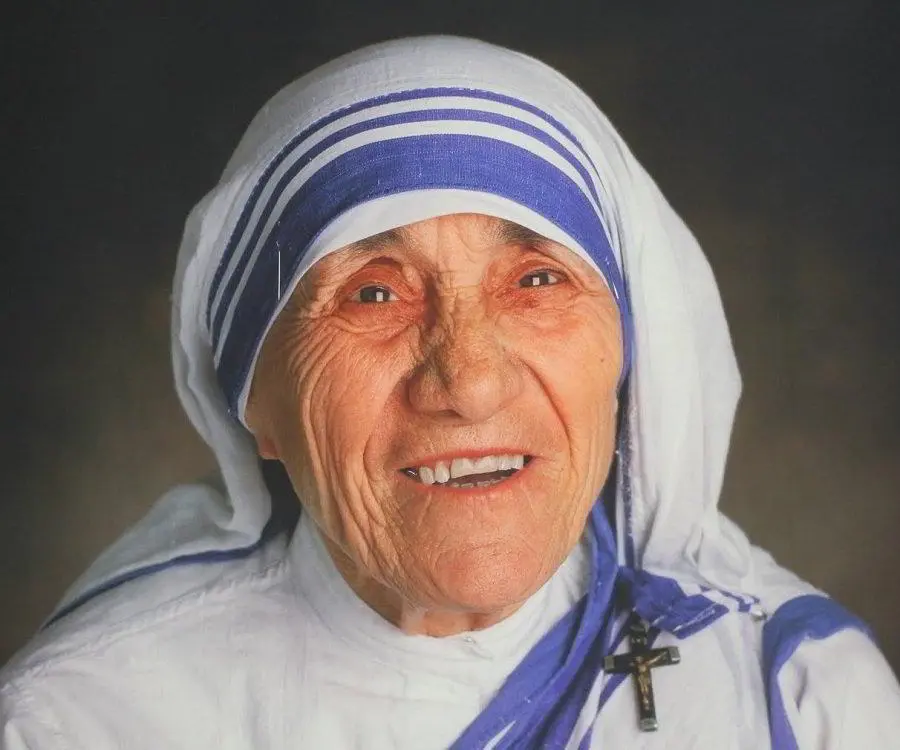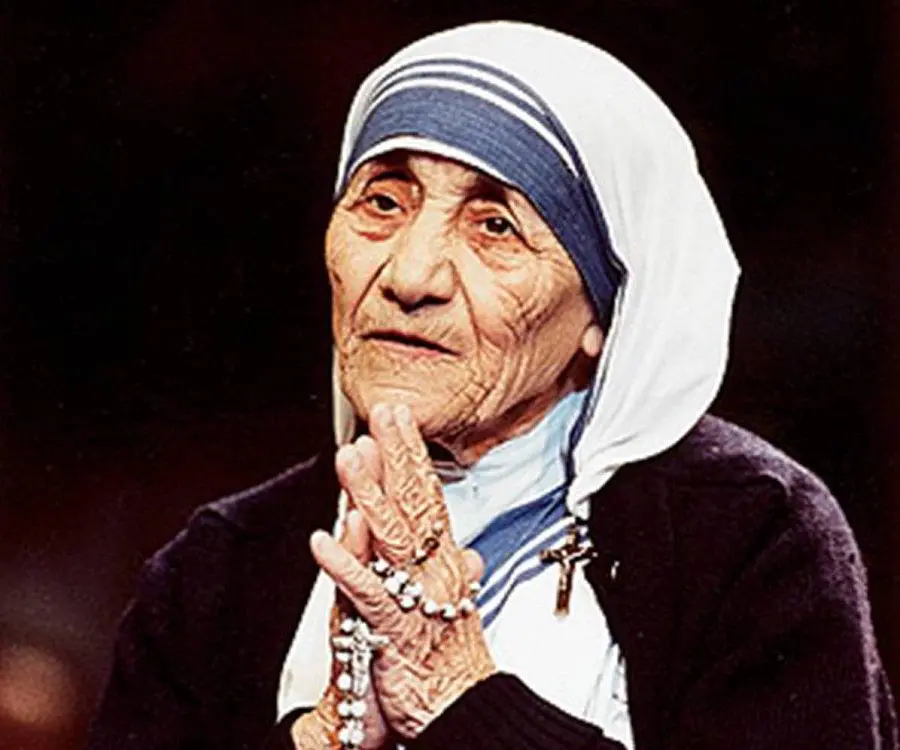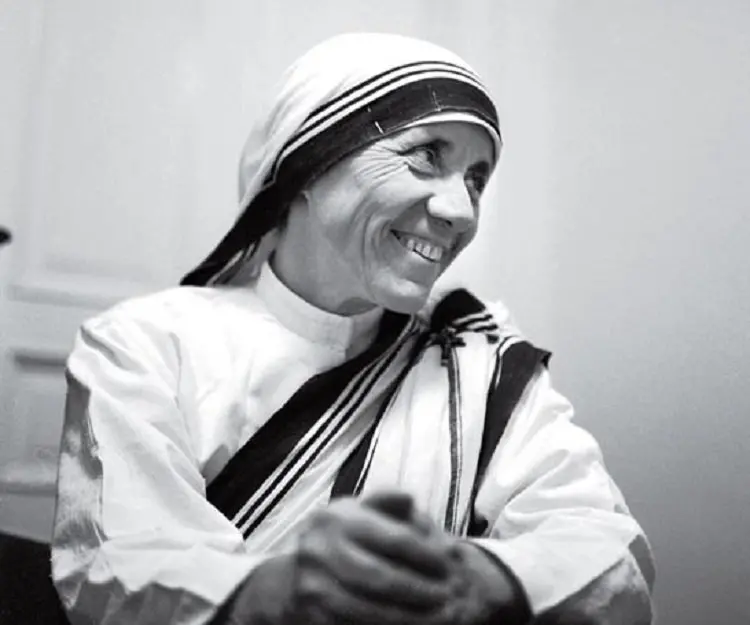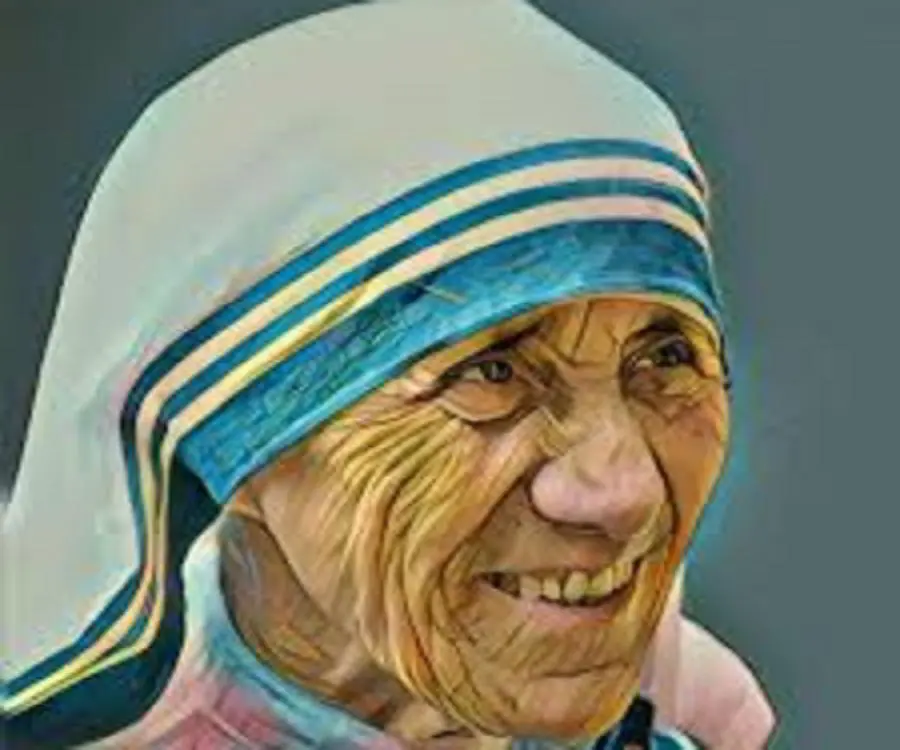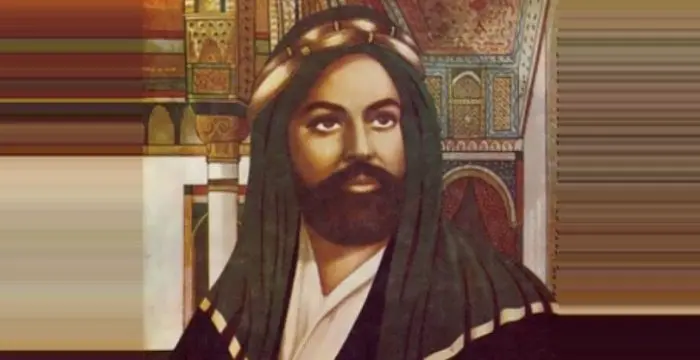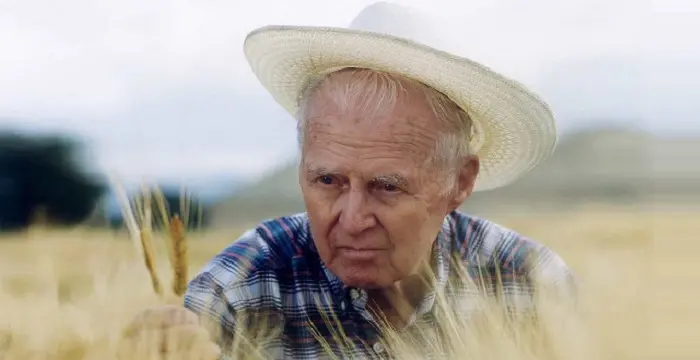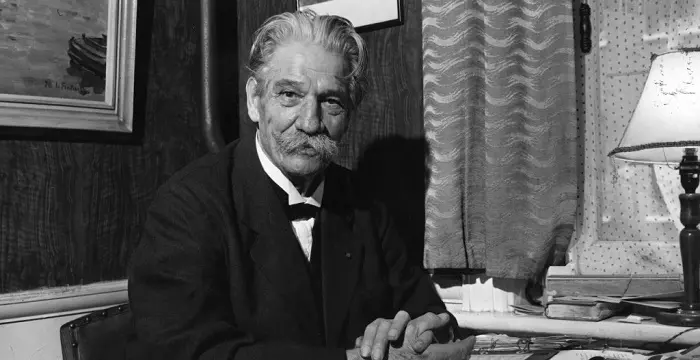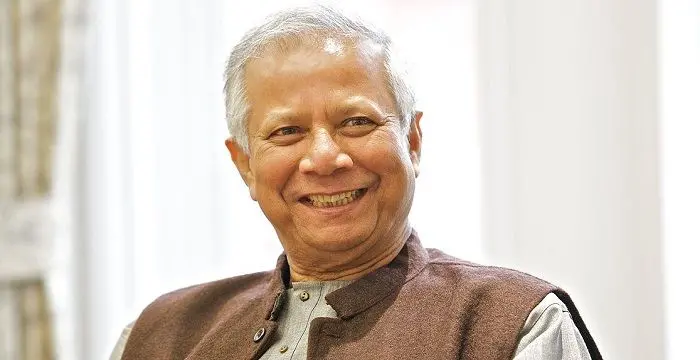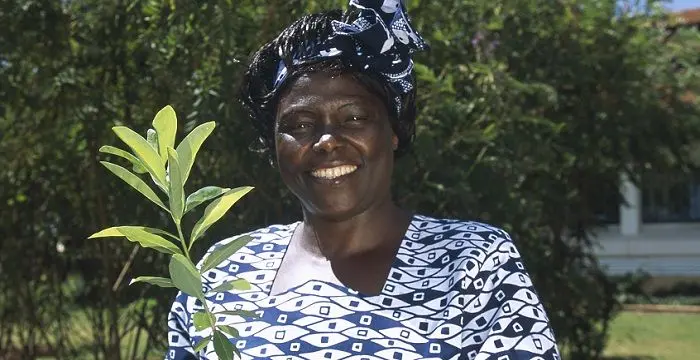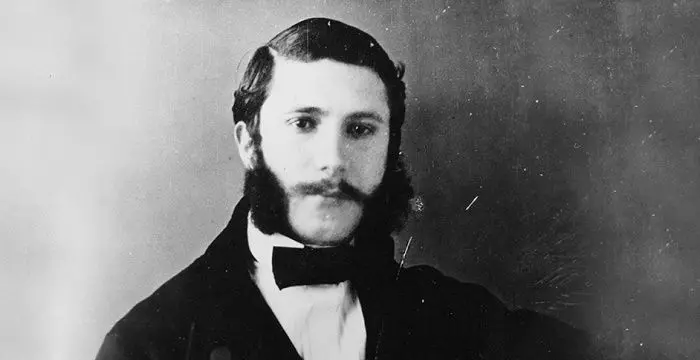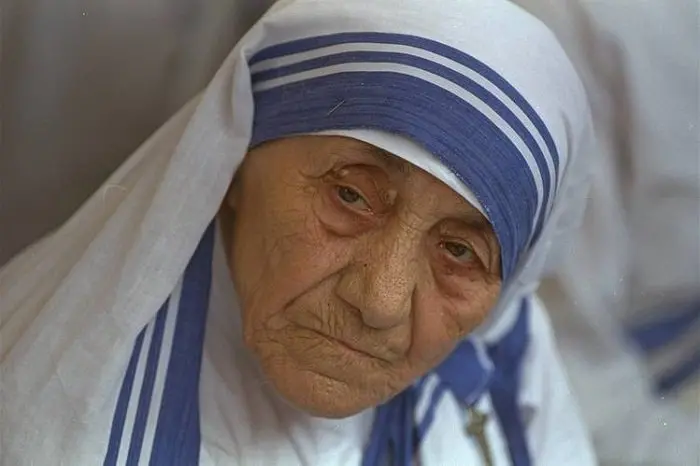
Mother Teresa - Founder of Missionaries of Charity, Family and Childhood
Mother Teresa's Personal Details
All through her life, Mother Teresa served people selflessly
| Information | Detail |
|---|---|
| Birthday | August 26, 1910 |
| Died on | September 5, 1997 |
| Nationality | Albanian, Indian |
| Famous | Humanitarian, Nobel Peace Prize, Leaders, Spiritual & Religious Leaders, ISFJ, Founder of Missionaries of Charity |
| Nick names | Saint Teresa of Calcutta |
| Siblings | Aga Bojaxhiu, Lazar Bojaxhiu |
| Known as | Anjezë Gonxhe Bojaxhiu |
| Birth Place | Skopje |
| Born Country | Albania |
| Religion | Roman Catholic |
| Gender | Female |
| Father | Nikollë |
| Mother | Dranafile Bojaxhiu |
| Sun Sign | Virgo |
| Born in | Skopje |
| Famous as | Founder of Missionaries of Charity |
| Died at Age | 87 |
Mother Teresa's photo
Who is Mother Teresa?
Clad in a white, blue-bordered sari, she along with her sisters of the Missionaries of Charity became a symbol of love, care and compassion for the world. Blessed Teresa of Calcutta, known the world over as Mother Teresa, was an Albanian-born Indian citizen who abided by her religious faith of Roman Catholicism to serve the unwanted, unloved and uncared people of the world. One of the greatest humanitarians of the 20th century, she led all her life serving the poorest of the poor. She was a ray of hope for many, including the aged, the destitute, the unemployed, the diseased, the terminally ill, and those abandoned by their families. Blessed with profound empathy, unwavering commitment and unshakable faith since young, she turned her back to the worldly pleasures and focussed on serving the mankind ever since she was 18. After years of service as a teacher and mentor, Mother Teresa experienced a call within her religious call, which changed her course of life completely, making her what she is known as today. Founder of the Missionaries of Charity, with her fervent commitment and incredible organizational and managerial skills, she developed an international organization that aimed towards helping the impoverished. For her service to the humanity she was honoured with Nobel Peace Prize in 1979. She was canonised by Pope Francis on 4 September 2016.
// Famous Leaders
Edi Rama
Edi Rama is the current Prime Minister of Albania. Check out this biography to know about his childhood, life, achievements, works & timeline.
Tecumseh
Tecumseh was a Native American leader of the Shawnee clan. This biography profiles his childhood, life and timeline.
Khalifa bin Zayed Al Nahyan
Sheikh Khalifa bin Zayed Al Nahyan is the current President of the United Arab Emirates (UAE). Check out this biography to know about his birthday, childhood, family life, achievements and fun facts about him.
Childhood & Early Life
Born to Nikolle and Dranafile Bojaxhiu in Skopje, Mother Teresa was the youngest child of the Albanian couple. She was born on August 26, 1910 and was baptized the following day as Agnes Gonxhe Bojaxhiu, a date she considered her ‘true birthday’. She received her First Communion when she was five and a half.
Raised in a devoutly Catholic family, her father was an entrepreneur by profession. Her mother had a spiritual and religious bent of mind and was active participant in the local church activities.
Sudden and tragic death of her father when she was eight years old left young Agnes disheartened. Despite facing financial crisis, Dranafile did not compromise on the upbringing of her children and raised them with utmost love, care and affection. Over the years, young Agnes grew extremely close to her mother.
It was Dranafile’s firm belief and religious attitude that greatly influenced Agnes character and future vocation. A pious and compassionate woman, she instilled in Agnes a deep commitment to charity, which was further affirmed by her involvement in the Jesuit parish of the Sacred Heart.
Religious Calling
As Agnes turned 18, she found her true calling as a nun and left home for good to enrol herself at the Institute of the Blessed Mary Virgin, also called Sisters of Loreto, in Ireland. It was there that she first received the name Sister Mary Teresa after St Therese of Lisieux.
After a year of training, Sister Mary Teresa came to India in 1929 and initiated her novitiate in Darjeeling, West Bengal, as a teacher at St Teresa’s School. She learned the local language of the state, Bengali.
Sister Teresa took her first religious vows in May 1931. Thereafter, she was assigned duty at the Loreto Entally community of Calcutta and taught at St Mary’s School.
Six years later, on May 24, 1937, she took her Final Profession of Vows and with that acquired the name, which the world recognizes her with today, Mother Teresa. The next twenty years of her life, Mother Teresa dedicated to serving as a teacher at the St Mary’s School, graduating to the post of the principal in 1944.
Within the walls of the convent, Mother Teresa was known for her love, kindness, compassion and generosity. Her unflinching commitment to serving the society and mankind was greatly recognized by students and teachers. However, just as much Mother Teresa enjoyed teaching young girls, she was greatly disturbed by the poverty and misery that was prevalent in Calcutta.
Call Within a Call
Little did she know that the journey from Calcutta to Darjeeling made by Mother Teresa for her yearly retreat, on September 10, 1946 would transform her life completely.
She experienced a call within a call - a call from the Almighty to fulfil His heartfelt desire of serving the ‘poorest of the poor’. Mother Teresa explained the experience as an order from Him, which she could not fail on any condition as it would mean breaking the faith.
He asked Mother Teresa to establish a new religious community, Missionaries of Charity Sisters, which would be dedicated to serving the ‘poorest of the poor’. The community would work in the slums of Calcutta and help the poorest and sick people.
Since Mother Teresa had taken a vow of obedience, leaving the convent without official permission was impossible. For nearly two years, she lobbied for initiating the new religious community, which brought favourable result in the January of 1948 as she received a final approval from the local Archbishop Ferdinand Perier to pursue the new calling.
On August 17, 1948, clad in a white blue-bordered saree, Mother Teresa walked past the gate of the convent, which had been her habitat for almost two decades, to enter the world of poor, a world that needed her, a world which He wanted her to serve, a world she knew of as her own!
Gaining Indian citizenship, Mother Teresa travelled all the way to Patna, Bihar to gain medical training at the Medical Mission Sisters. After completing her short course, Mother Teresa returned to Calcutta and found her temporary lodging at Little Sisters of the Poor.
Her first outing was on December 21, 1948 to help the people in the slums. Her main mission was to serve Him by helping the ‘unwanted, unloved, and uncared’. From then on, Mother Teresa reached out to the poor and needy each day, fulfilling His desire to radiate love, kindness and compassion.
Starting off all alone, Mother Teresa was soon joined by voluntary helpers, most of which were former students and teachers, who accompanied her in her mission to fulfil His vision. With time, financial help also came in.
Mother Teresa then started an open air school and soon established a home for the dying and destitute in a dilapidated home, which she convinced the government to donate to her.
October 7, 1950 was historic day in the life of Mother Teresa; she finally received permission by the Vatican to start the congregation that eventually came to be known as Missionaries of Charity.
Starting off with merely 13 members, the Missionaries of Charity went on to become one of the most significant and recognized congregations in the world. As the ranks of congregation raised and financial aid came in easily, Mother Teresa expanded her scope for charitable activities exponentially.
In 1952, she inaugurated the first Home for the Dying, where people brought to this home received medical help and accorded the opportunity to die with dignity. Adhering to the different faith that people came in from, all who died were given their last ceremonies according to the religion they followed, thus dying a death of dignity.
The next step was initiating a home for those suffering from Hansen's disease, commonly known as leprosy. The home was called Shanti Nagar. Additionally, several clinics were formed in the city of Calcutta which provided medication, bandage and food to those suffering from leprosy.
In 1955, Mother Teresa opened a home for the orphans and homeless youths. She named it as Nirmala Shishu Bhavan, or the Children's Home of the Immaculate Heart.
What started as a small effort soon grew in size and number, attracting recruits and financial help. By 1960, Missionaries of Charity had opened several hospices, orphanages and leper houses all over India.
Meanwhile, in 1963, Missionaries of Charity Brothers was founded. The main aim behind the inauguration of Missionaries of Charity Brother was to better respond to the physical and spiritual needs of the poor.
Furthermore, in 1976, a contemplative branch of the sisters was opened. Two years later, a contemplative brothers’ branch was inaugurated. In 1981, she began the Corpus Christi Movement for Priests and in 1984 the Missionaries of Charity Fathers was initiated. The initiation of the same was to combine the vocational aim of Missionaries of charity with the resource of ministerial priesthood.
Mother Teresa, then, formed the Co-Workers of Mother Teresa, the Sick and Suffering Co-Workers, and the Lay Missionaries of Charity.
Her International Pursuits
The congregation, which was limited to India, opened its first house outside India in Venezuela in 1965 with five sisters. However, this was just the beginning, as many more houses came up in Rome, Tanzania and Austria. By 1970s, the order had reached several countries in Asia, Africa, Europe and United States.
In 1982, Mother Teresa rescued almost 37 children who were trapped in a front line hospital in Beirut. With the help of a few Red Cross volunteers, she crossed the war zone to reach the devastated hospital and evacuate young patients.
Missionaries of Charity which was rejected by the Communist countries earlier, found an acceptance in the 1980s. Ever since it attained permission, the congregation initiated a dozen of projects. She helped the earthquake victims of Armenia, the famished folks of Ethiopia and the radiation-caused victims of Chernobyl.
The first Missionaries of Charity home in the United States was established in the South Bronx, New York. By 1984, it had 19 establishments all over the country.
In 1991, Mother Teresa returned to her homeland for the first time since 1937 and opened a Missionaries of Charity Brothers home in Tirana, Albania.
By 1997, Missionaries of Charity had almost 4000 sisters working in 610 foundations, in 450 centres in 123 countries across the sIX continents. The congregation had several hospices and homes for people with HIV/AIDS, leprosy and tuberculosis, soup kitchens, children's and family counselling programs, personal helpers, orphanages, and schools functioning under it.
Awards & Achievements
For her unwavering commitment and unflinching love and compassion that she devoutly shared, the Government of India honoured her with Padma Shri, Jawaharlal Nehru Award for International Understanding and Bharat Ratna, India’s highest civilian award.
In 1962, she was honoured with Ramon Magsaysay Award for International Understanding, for her merciful cognizance of the abject poor of a foreign land, in whose service she led a new congregation.
In 1971, she was awarded the first Pope John XXIII Peace Prize for her work with the poor, display of Christian charity and efforts for peace.
In 1979, Mother Teresa was awarded the Nobel Peace Prize, "for work undertaken in the struggle to overcome poverty and distress, which also constitutes a threat to peace."
Death & Legacy
Mother Teresa’s health started declining in the 1980s. The first instance of the same was seen when she suffered a heart attack while visiting Pope John Paul II in Rome in 1983.
For the next decade, Mother Teresa constantly faced health issues. Cardiac problems seemed to live by her, as she experienced no respite even after heart surgery.
Her declining health led her to step down as the head of the order on March 13, 1997. Her last visit abroad was to Rome, when she visited Pope John Paul II for the second time.
Upon returning to Calcutta, Mother Teresa spent her last few days receiving visitors and instructing sisters. The greatly compassionate soul left for the heavenly abode on September 5, 1997. Her death was mourned by the world over.
The world has commemorated this saintly soul through various ways. She has been memorialized and has been made patroness of various churches. There are also several roads and structures that have been named after Mother Teresa. She has also been seen in popular cultures.
In 2003, Mother Teresa was beautified by Pope John Paul II at St Peter’s Basilica, in Vatican City. Since then, she has been known as Blessed Mother Teresa. Along with Blessed Pope John Paul II, the Church designated Blessed Teresa of Calcutta as the patron saint of the World Youth Day.
She was canonised by Pope Francis on 4 September 2016 and is now known as Saint Teresa of Calcutta.
Trivia
Known the world over as Mother Teresa, she however was not baptized with the same name. Her christened name is different from what she is known as.
She founded the Missionaries of Charity in Calcutta with the objective of serving the poorest of the poor. She aimed to make life beautiful for the unwanted, unloved and uncared lot.
Top 10 Facts You Did Not Know About Mother Teresa
Though incredibly close to her mother, she never saw her again after the day she left for Ireland.
As Sister Teresa, she set aside her nun’s habit in 1948 and adopted instead the simple sari and sandals to fit in with the women she worked with.
When she was awarded the Nobel Peace Prize, she refused the traditional Nobel honor banquet and requested that the $192,000 budget be allocated to help the poor in India.
The only international airport in Albania, Tirana International Airport (Nënë Tereza) is named after Mother Teresa.
As a teacher in Kolkata, she taught history and geography at St Mary’s School.
Pope Paul VI came to meet her in 1965 but she informed him that she was too busy with her work among the poor to meet with him. The pope was much impressed with her sincerity.
Mother Teresa was strictly pro-life and was against abortion and contraceptives.
In spite of being deeply religious, she frequently questioned her own belief in God.
Upon her death, the Indian government gave her a state funeral honoring her work with the poor and needy.
She was voted as one of the 10 most admirable women 18 times in Gallup's yearly poll.
// Famous Spiritual & Religious Leaders
Swami Vivekananda
Swami Vivekananda was the chief disciple of Sri Ramakrishna, and was responsible for awakening India spiritually. Check this biography to know in detail about his life, profile and timeline.
Prophet Muhammad
Prophet Muhammad was the founder of Islam, one of the most widespread religions in the world. This biography profiles his childhood, life story, achievements and more.
Murad IV
Murad IV was one of the mighty Sultans in the history of the Ottoman Empire. This biography profiles his childhood, family, accession, rule, administration and timeline.
Mother Teresa's awards
| Year | Name | Award |
|---|---|---|
Other | ||
| 1971 | Pope John XXIII Peace Prize | |
| 1976 | Pacem in Terris Award | |
| 1978 | Balzan Prize | |
| 1979 | Nobel Peace Prize | |
| 0 | 1962 - Padma Shri | |
| 0 | 1969 - Jawaharlal Nehru Award for International Understanding | |
| 0 | 1962 - Ramon Magsaysay Award | |
Mother Teresa biography timelines
- // 26th Aug 1910Born to Nikolle and Dranafile Bojaxhiu in Skopje, Mother Teresa was the youngest child of the Albanian couple. She was born on August 26, 1910 and was baptized the following day as Agnes Gonxhe Bojaxhiu, a date she considered her ‘true birthday’. She received her First Communion when she was five and a half.
- // 1928As Agnes turned 18, she found her true calling as a nun and left home for good to enrol herself at the Institute of the Blessed Mary Virgin, also called Sisters of Loreto, in Ireland. It was there that she first received the name Sister Mary Teresa after St Therese of Lisieux.
- // 1929After a year of training, Sister Mary Teresa came to India in 1929 and initiated her novitiate in Darjeeling, West Bengal, as a teacher at St Teresa’s School. She learned the local language of the state, Bengali.
- // 1937Sister Teresa took her first religious vows in May 1931. Thereafter, she was assigned duty at the Loreto Entally community of Calcutta and taught at St Mary’s School.
- // 1937Six years later, on May 24, 1937, she took her Final Profession of Vows and with that acquired the name, which the world recognizes her with today, Mother Teresa. The next twenty years of her life, Mother Teresa dedicated to serving as a teacher at the St Mary’s School, graduating to the post of the principal in 1944.
- // 1946Little did she know that the journey from Calcutta to Darjeeling made by Mother Teresa for her yearly retreat, on September 10, 1946 would transform her life completely.
- // Jan 1948Since Mother Teresa had taken a vow of obedience, leaving the convent without official permission was impossible. For nearly two years, she lobbied for initiating the new religious community, which brought favourable result in the January of 1948 as she received a final approval from the local Archbishop Ferdinand Perier to pursue the new calling.
- // 17th Aug 1948On August 17, 1948, clad in a white blue-bordered saree, Mother Teresa walked past the gate of the convent, which had been her habitat for almost two decades, to enter the world of poor, a world that needed her, a world which He wanted her to serve, a world she knew of as her own!
- // 21st Dec 1948Her first outing was on December 21, 1948 to help the people in the slums. Her main mission was to serve Him by helping the ‘unwanted, unloved, and uncared’. From then on, Mother Teresa reached out to the poor and needy each day, fulfilling His desire to radiate love, kindness and compassion.
- // 7th Oct 1950October 7, 1950 was historic day in the life of Mother Teresa; she finally received permission by the Vatican to start the congregation that eventually came to be known as Missionaries of Charity.
- // 1952In 1952, she inaugurated the first Home for the Dying, where people brought to this home received medical help and accorded the opportunity to die with dignity. Adhering to the different faith that people came in from, all who died were given their last ceremonies according to the religion they followed, thus dying a death of dignity.
- // 1955In 1955, Mother Teresa opened a home for the orphans and homeless youths. She named it as Nirmala Shishu Bhavan, or the Children's Home of the Immaculate Heart.
- // 1960What started as a small effort soon grew in size and number, attracting recruits and financial help. By 1960, Missionaries of Charity had opened several hospices, orphanages and leper houses all over India.
- // 1962In 1962, she was honoured with Ramon Magsaysay Award for International Understanding, for her merciful cognizance of the abject poor of a foreign land, in whose service she led a new congregation.
- // 1963Meanwhile, in 1963, Missionaries of Charity Brothers was founded. The main aim behind the inauguration of Missionaries of Charity Brother was to better respond to the physical and spiritual needs of the poor.
- // 1965The congregation, which was limited to India, opened its first house outside India in Venezuela in 1965 with five sisters. However, this was just the beginning, as many more houses came up in Rome, Tanzania and Austria. By 1970s, the order had reached several countries in Asia, Africa, Europe and United States.
- // 1971In 1971, she was awarded the first Pope John XXIII Peace Prize for her work with the poor, display of Christian charity and efforts for peace.
- // 1976 To 1984Furthermore, in 1976, a contemplative branch of the sisters was opened. Two years later, a contemplative brothers’ branch was inaugurated. In 1981, she began the Corpus Christi Movement for Priests and in 1984 the Missionaries of Charity Fathers was initiated. The initiation of the same was to combine the vocational aim of Missionaries of charity with the resource of ministerial priesthood.
- // 1979In 1979, Mother Teresa was awarded the Nobel Peace Prize, "for work undertaken in the struggle to overcome poverty and distress, which also constitutes a threat to peace."
- // 1981In 1991, Mother Teresa returned to her homeland for the first time since 1937 and opened a Missionaries of Charity Brothers home in Tirana, Albania.
- // 1982In 1982, Mother Teresa rescued almost 37 children who were trapped in a front line hospital in Beirut. With the help of a few Red Cross volunteers, she crossed the war zone to reach the devastated hospital and evacuate young patients.
- // 1984The first Missionaries of Charity home in the United States was established in the South Bronx, New York. By 1984, it had 19 establishments all over the country.
- // 1997By 1997, Missionaries of Charity had almost 4000 sisters working in 610 foundations, in 450 centres in 123 countries across the sIX continents. The congregation had several hospices and homes for people with HIV/AIDS, leprosy and tuberculosis, soup kitchens, children's and family counselling programs, personal helpers, orphanages, and schools functioning under it.
- // 1997Her declining health led her to step down as the head of the order on March 13, 1997. Her last visit abroad was to Rome, when she visited Pope John Paul II for the second time.
- // 5th Sep 1997Upon returning to Calcutta, Mother Teresa spent her last few days receiving visitors and instructing sisters. The greatly compassionate soul left for the heavenly abode on September 5, 1997. Her death was mourned by the world over.
- // 2003In 2003, Mother Teresa was beautified by Pope John Paul II at St Peter’s Basilica, in Vatican City. Since then, she has been known as Blessed Mother Teresa. Along with Blessed Pope John Paul II, the Church designated Blessed Teresa of Calcutta as the patron saint of the World Youth Day.
- // 4th Sep 2016She was canonised by Pope Francis on 4 September 2016 and is now known as Saint Teresa of Calcutta.
// Famous Nobel Peace Prize
Emily Greene Balch
Emily Greene Balch was an American economist, sociologist and pacifist who won the 1946 Nobel Peace Prize. This biography of Emily Greene Balch provides detailed information about her childhood, life, achievements, works & timeline.
Norman Borlaug
Norman Borlaug was an American biologist known as the “Father of the Green Revolution”. This biography of Norman Borlaug provides detailed information about his childhood, life, achievements, works & timeline.
Albert Schweitzer
Albert Schweitzer was a German born French theologian, organist, philosopher, physician, and medical missionary. Check out this biography to know about his childhood, family life, and achievements.
Muhammad Yunus
Muhammad Yunus is the founder of the Grameen Bank in Bangladesh and the recipient of the 2006 Nobel Peace Prize. This biography of Muhammad Yunus provides detailed information about his childhood, life, achievements, works & timeline.
Wangari Maathai
Wangari Maathai was an environmentalist who won the prestigious Nobel Peace Prize Award. Go through this biography to explore details about her life, childhood, and timeline.
Henry Dunant
Henry Dunant or Jean Henri Dunant was a Swiss social and peace activist who founded the Red Cross and was the recipient of the first Nobel Peace Prize. This biography of Dunant profiles his childhood, life, humanitarian work, achievements & timeline.
Mother Teresa's FAQ
What is Mother Teresa birthday?
Mother Teresa was born at 1910-08-26
When was Mother Teresa died?
Mother Teresa was died at 1997-09-05
Where was Mother Teresa died?
Mother Teresa was died in Kolkata
Which age was Mother Teresa died?
Mother Teresa was died at age 87
Where is Mother Teresa's birth place?
Mother Teresa was born in Skopje
What is Mother Teresa nationalities?
Mother Teresa's nationalities is Albanian, Indian
What is Mother Teresa nick names?
Mother Teresa's nickNames is Saint Teresa of Calcutta
Who is Mother Teresa siblings?
Mother Teresa's siblings is Aga Bojaxhiu, Lazar Bojaxhiu
What is Mother Teresa's religion?
Mother Teresa's religion is Roman Catholic
Who is Mother Teresa's father?
Mother Teresa's father is Nikollë
Who is Mother Teresa's mother?
Mother Teresa's mother is Dranafile Bojaxhiu
What is Mother Teresa's sun sign?
Mother Teresa is Virgo
How famous is Mother Teresa?
Mother Teresa is famouse as Founder of Missionaries of Charity
